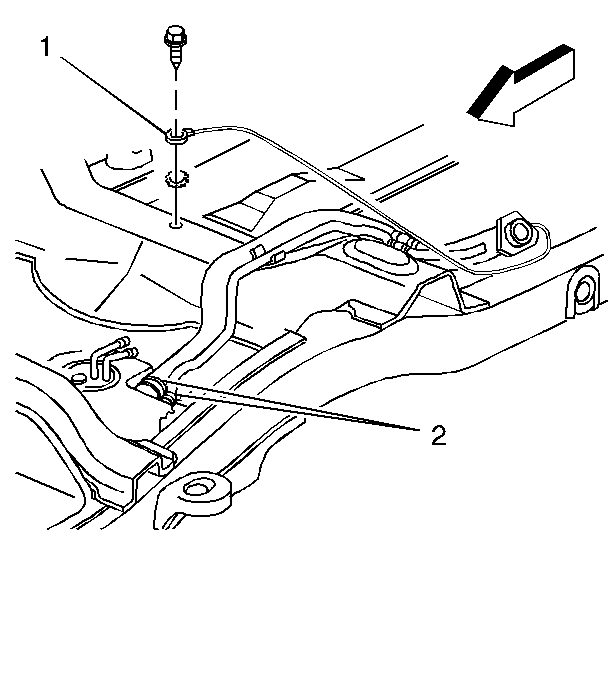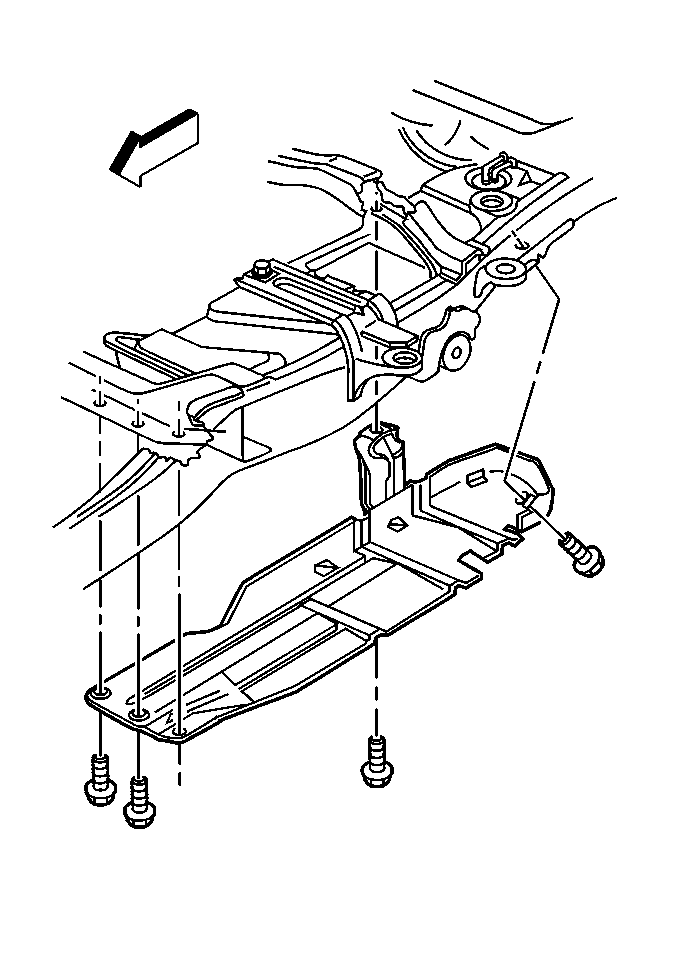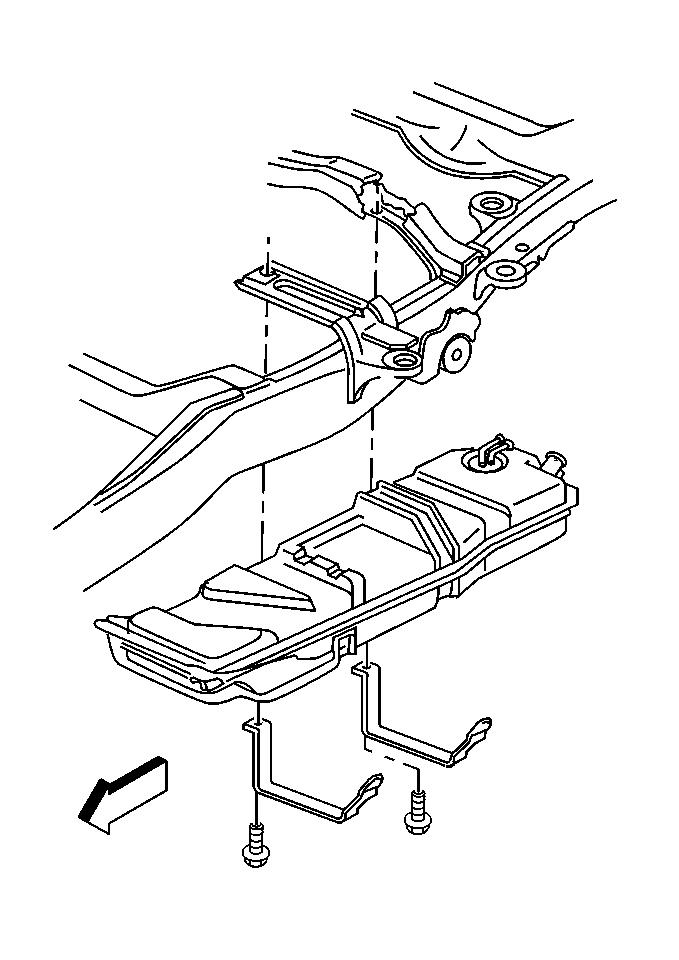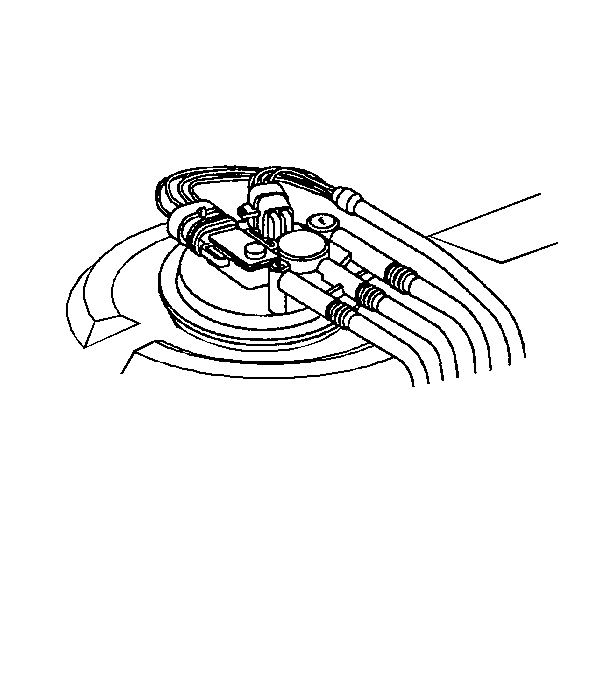Fuel Tank Replacement 4-Door Utility
Removal Procedure
Tools Required
J 39765 Fuel Sender Locknut Wrench
- Disconnect the negative battery cable.
- Drain the fuel from the tank. Refer to Fuel Tank Draining Procedure .
- Raise the vehicle.
- Loosen the filler neck hose clamp at the fuel tank (2).
- Disconnect the fuel tank filler neck from the fuel tank.
- Support the fuel tank.
- Remove the fuel tank shield.
- Remove the tank straps.
- Lower the fuel tank.
- Disconnect the fuel and vapor hoses and the electrical connections at the sender.
- Use tool J 39765 in order to remove the fuel sender and the seal ring.
- Discard the old seal ring.
Caution: Unless directed otherwise, the ignition and start switch must be in the OFF or LOCK position, and all electrical loads must be OFF before servicing any electrical component. Disconnect the negative battery cable to prevent an electrical spark should a tool or equipment come in contact with an exposed electrical terminal. Failure to follow these precautions may result in personal injury and/or damage to the vehicle or its components.
Notice: When jacking or lifting a vehicle, do not allow the lift pads to contact any
of the following parts:
• The catalytic converter • The brake lines • The brake cables • The fuel lines • The accelerator cables • The transmission shift cables



Notice: Ensure that the connections to both roll over valves are disconnected prior to lowering the fuel tank more than 51 mm (2 in). The roll over valves are located at both the front and rear of the fuel tank.
Notice: Use extreme care when lowering the fuel tank. The fuel sender is made of plastic. Lowering the fuel tank may damage the fuel sender.


Installation Procedure
- Install a new seal ring.
- Reinstall sender using tool J 39765 .
- Raise tank slightly.
- Reconnect the fuel and vapor hoses and the electrical connections at the sender.
- Raise the tank fully.
- Reinstall the fuel tank filler neck to the tank.
- Tighten the clamp.
- Install the fuel tank brackets with insulator strips in place.
- Install the fuel tank shield
- Lower the vehicle.
- Refill the fuel tank.
- Reinstall fuel tank filler cap.
- Reconnect the negative battery cable.
- Check for leaks.

Notice: Do not fold or twist the strainer when installing the sending unit. This action restricts fuel flow.

Ensure the ground strap is also reinstalled to the body.


Notice: Tighten the strap fasteners by steps, alternating between the fasteners, until the specified torque is reached. A failure to tighten the strap fasteners as specified will cause the bottom of the tank to flex upward. This will result in the fuel gauge indicating that there is fuel remaining in the tank when the tank is empty.
Notice: Use the correct fastener in the correct location. Replacement fasteners must be the correct part number for that application. Fasteners requiring replacement or fasteners requiring the use of thread locking compound or sealant are identified in the service procedure. Do not use paints, lubricants, or corrosion inhibitors on fasteners or fastener joint surfaces unless specified. These coatings affect fastener torque and joint clamping force and may damage the fastener. Use the correct tightening sequence and specifications when installing fasteners in order to avoid damage to parts and systems.
Important: When removing or replacing the fuel tank, the fuel tank support fasteners should never be reused. Always use new fasteners when installing the fuel tank.
Tighten
Tighten the strap nuts to 45 N·m (33 lb ft.).

If a memory retention device was not used, reset (to the extent possible) all devices that lost memory after the battery was disconnected.
